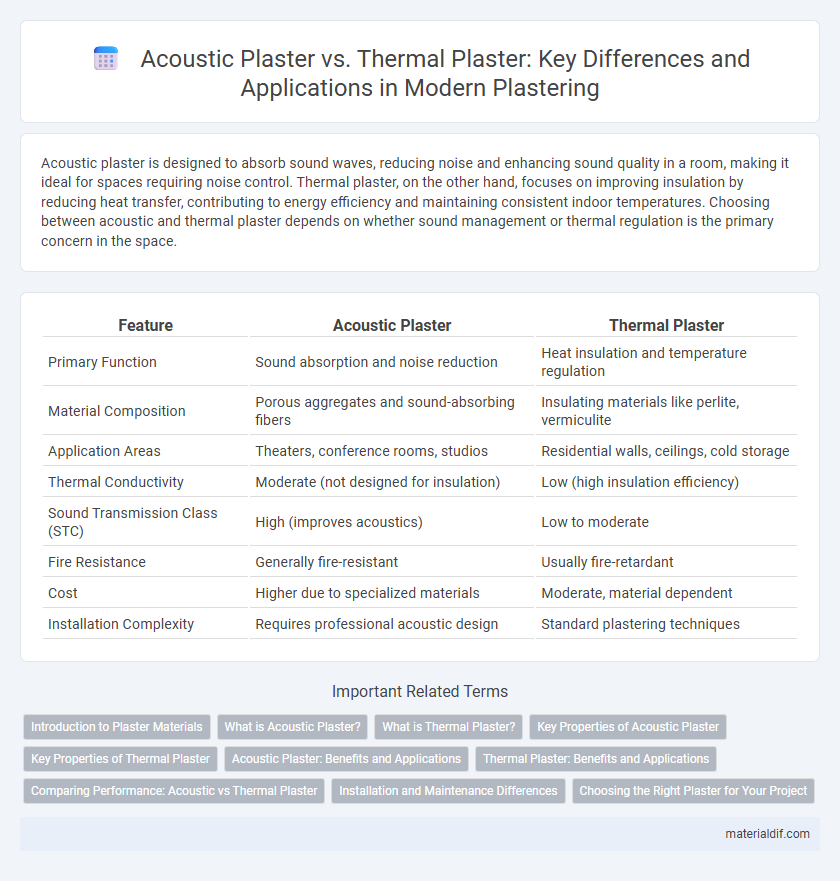Acoustic plaster is designed to absorb sound waves, reducing noise and enhancing sound quality in a room, making it ideal for spaces requiring noise control. Thermal plaster, on the other hand, focuses on improving insulation by reducing heat transfer, contributing to energy efficiency and maintaining consistent indoor temperatures. Choosing between acoustic and thermal plaster depends on whether sound management or thermal regulation is the primary concern in the space.
Table of Comparison
| Feature | Acoustic Plaster | Thermal Plaster |
|---|---|---|
| Primary Function | Sound absorption and noise reduction | Heat insulation and temperature regulation |
| Material Composition | Porous aggregates and sound-absorbing fibers | Insulating materials like perlite, vermiculite |
| Application Areas | Theaters, conference rooms, studios | Residential walls, ceilings, cold storage |
| Thermal Conductivity | Moderate (not designed for insulation) | Low (high insulation efficiency) |
| Sound Transmission Class (STC) | High (improves acoustics) | Low to moderate |
| Fire Resistance | Generally fire-resistant | Usually fire-retardant |
| Cost | Higher due to specialized materials | Moderate, material dependent |
| Installation Complexity | Requires professional acoustic design | Standard plastering techniques |
Introduction to Plaster Materials
Acoustic plaster is specifically designed with sound-absorbing properties to enhance room acoustics by reducing echo and noise levels. Thermal plaster incorporates insulating materials that improve energy efficiency by regulating heat transfer through walls and ceilings. Both types of plaster utilize advanced formulations tailored to their functional purposes, making them essential in modern construction for comfort and performance.
What is Acoustic Plaster?
Acoustic plaster is a specialized building material designed to enhance sound absorption and reduce noise within indoor spaces, making it ideal for theaters, offices, and auditoriums. Unlike thermal plaster, which primarily insulates against heat transfer, acoustic plaster contains porous or fibrous components that trap sound waves and minimize echo. This innovative plaster combines aesthetic appeal with functional soundproofing, improving acoustic comfort without compromising wall finishes.
What is Thermal Plaster?
Thermal plaster is an insulating material applied to walls and ceilings to reduce heat transfer and improve energy efficiency in buildings. It contains additives that enhance its thermal resistance, helping to maintain consistent indoor temperatures and lower heating and cooling costs. Unlike acoustic plaster, which primarily targets sound absorption, thermal plaster focuses on enhancing thermal insulation properties.
Key Properties of Acoustic Plaster
Acoustic plaster is specially formulated to enhance sound absorption and reduce noise levels in indoor spaces, featuring porous materials that effectively dissipate sound waves. Its key properties include high sound absorption coefficients, fire resistance, and a smooth, seamless finish that integrates easily with interior design. Unlike thermal plaster, which prioritizes insulation and temperature regulation, acoustic plaster primarily focuses on improving acoustic comfort and controlling reverberation.
Key Properties of Thermal Plaster
Thermal plaster is specifically designed to enhance insulation by reducing heat transfer through walls, improving energy efficiency in buildings. Its key properties include low thermal conductivity, high fire resistance, and excellent moisture regulation, which contribute to maintaining a stable indoor temperature. Unlike acoustic plaster, which focuses on sound absorption, thermal plaster primarily addresses thermal performance and energy savings.
Acoustic Plaster: Benefits and Applications
Acoustic plaster enhances sound absorption by reducing reverberation and background noise, making it ideal for theaters, auditoriums, and recording studios. Its porous composition improves speech clarity and audio quality while maintaining an aesthetically seamless finish. Beyond soundproofing, acoustic plaster contributes to indoor comfort by minimizing noise pollution, which is essential in offices and educational environments.
Thermal Plaster: Benefits and Applications
Thermal plaster is designed to improve building insulation by reducing heat transfer, thereby enhancing energy efficiency and lowering heating and cooling costs. Its application in walls and ceilings helps maintain indoor temperature stability while providing a breathable barrier that prevents moisture buildup. Ideal for residential and commercial buildings, thermal plaster supports sustainable construction practices and improves occupant comfort.
Comparing Performance: Acoustic vs Thermal Plaster
Acoustic plaster is engineered to absorb sound waves, reducing noise and echo in spaces, while thermal plaster enhances insulation by minimizing heat transfer through walls. Performance comparison shows acoustic plaster excels in sound attenuation with materials like mineral fibers or perforated layers, whereas thermal plaster typically incorporates insulating additives such as expanded perlite or vermiculite to improve energy efficiency. Both plasters serve distinct purposes: acoustic plaster optimizes auditory comfort, and thermal plaster focuses on maintaining temperature regulation within buildings.
Installation and Maintenance Differences
Acoustic plaster is installed using sound-absorbing materials that require precise layering and specialized fastening to optimize noise reduction, while thermal plaster involves applying insulating components that enhance heat retention and may need thicker, more uniform coatings. Maintenance for acoustic plaster often includes periodic inspection for damage that can affect soundproofing efficiency, whereas thermal plaster demands checks for cracks or moisture intrusion to maintain insulation properties. Proper installation of both types ensures longevity, but acoustic plaster typically requires more meticulous handling during application to preserve its acoustic performance.
Choosing the Right Plaster for Your Project
Acoustic plaster is specifically designed to absorb sound, reducing noise pollution and improving room acoustics, making it ideal for theaters, studios, and offices. Thermal plaster enhances insulation by regulating temperature and increasing energy efficiency, which is perfect for residential buildings and energy-conscious projects. Selecting the right plaster depends on your project's primary goals, whether prioritizing sound control or thermal performance for optimal results.
Acoustic Plaster vs Thermal Plaster Infographic

 materialdif.com
materialdif.com